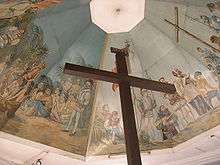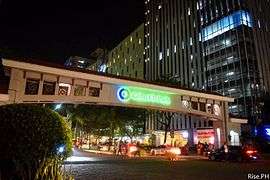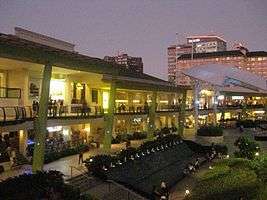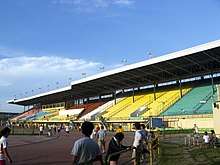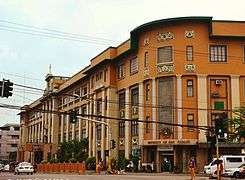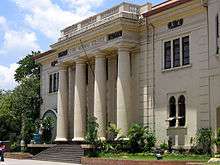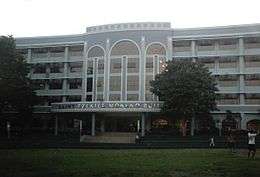Cebu City
Cebu City, officially the City of Cebu (Cebuano: Dakbayan sa Sugbo; Tagalog: Lungsod ng Cebu; Spanish: Ciudad de Cebu), is a 1st class highly urbanized city of the island of Cebu in the Central Visayas Region, Philippines. According to the 2015 census, it has a population of 922,611 people,[3] making it the fifth-most populated city in the nation and the most populous in Visayas.
Cebu City Dakbayan sa Sugbo | |
|---|---|
| City of Cebu | |
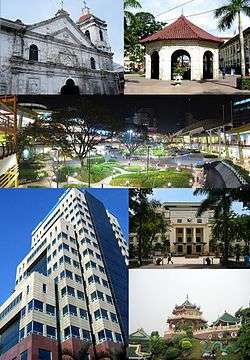 | |
| Nicknames: Queen City of the South First Capital of the Philippines Oldest City in the Philippines | |
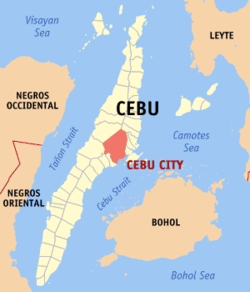 Map of Central Visayas with Cebu City highlighted | |
OpenStreetMap 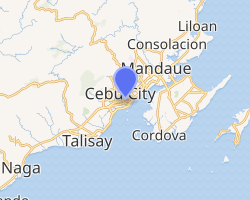
| |
.svg.png) Cebu City Location within the Philippines | |
| Coordinates: 10°18′N 123°54′E | |
| Country | |
| Region | Central Visayas (Region VII) |
| Province | Cebu (geographically only) |
| District | 1st (North) and 2nd (South) districts of Cebu City |
| Founded (as Spanish colony) Reincorporated (as city) | 1565 24 February 1937 |
| Barangays | 80 (see Barangays) |
| Government | |
| • Type | Sangguniang Panlungsod |
| • Mayor | Edgardo C. Labella |
| • Vice Mayor | Michael L. Rama |
| • City Council | Councilors
|
| • Representatives | Congress
|
| • Electorate | 709,608 voters (2019) |
| Area | |
| • City | 315.00 km2 (121.62 sq mi) |
| • Metro | 1,062.88 km2 (410.38 sq mi) |
| Area rank | 34th out of 145 |
| Population (2015 census)[3] | |
| • City | 922,611 |
| • Rank | 5th |
| • Density | 2,900/km2 (7,600/sq mi) |
| • Metro | 2,849,213 |
| • Metro density | 2,700/km2 (6,900/sq mi) |
| • Households | 204,409 |
| Demonym(s) | Cebuano Cebuana |
| Economy | |
| • Income class | 1st city income class |
| • Poverty incidence | 12.61% (2015)[4] |
| • Revenue (₱) | 4,386,168,199.41 (2016) |
| Time zone | UTC+8 (PST) |
| ZIP code | 6000 |
| PSGC | |
| IDD : area code | +63 (0)32 |
| Climate type | tropical climate |
| Native languages | Cebuano Tagalog |
| Sister localities | Sister Cities
of Cebu City |
| Dominant religion | Roman Catholicism - 80 % |
| Notable festival | Sinulog Festival - Third Sunday of January |
| Catholic diocese | Archdiocese of Cebu |
| Patron saint | Patron Saints
of Cebu City |
| Website | www |
It is the regional center of Central Visayas and is the seat of government for the province of Cebu, but is governed separately from it. The city is a significant center of commerce, trade and education in Visayas. It is the Philippines' main domestic shipping port and is home to about 80% of the country's domestic shipping companies.
Located in the middle of the eastern side of Cebu Island, it is the center of Metro Cebu, the second largest metropolitan area in the Philippines by population, economy and land area, which includes the cities of Carcar, Danao, Lapu-Lapu, Mandaue, Naga and Talisay and the municipalities (towns) of Compostela, Consolacion, Cordova, Liloan, Minglanilla and San Fernando. Metro Cebu had a total population of 2,849,213 as of 2015, making it the second-most populous metropolitan area of the nation, after Metro Manila in Luzon.[5]
Cebu is the country's oldest city; it was the first Spanish settlement[6] and the first capital of the Philippines. It is the "Second City" of the Philippines. The city is considered the birthplace of Christianity in the Far East.[7][8][9][10]
Cebu is bounded on the north by the town of Balamban and the city of Danao, on the west by the city of Toledo, on the east by the cities of Lapu-Lapu and Mandaue and the towns of Liloan, Consolacion and Compostela and on the south by the city of Talisay.
It has entered the list of Condé Nast Traveler thrice: Last 2016, 2017 and 2019. In all years, Boracay led the list. The entire Visayas also ranked second with it on 2019, even the leading Boracay is also part of it.
Etymology
The name "Cebu" came from the old Cebuano word sibu or sibo ("trade"), a shortened form of sinibuayng hingpit ("the place for trading"). It was originally applied to the harbors of the town of Sugbu, the ancient name for Cebu City. Sugbu or Sugbo, in turn, was derived from the Old Cebuano term for "scorched earth" or "great fire".[11][12]
History
Founding
Before the arrival of the Spaniards, Cebu city was part of the island-rajahnate and trade center of Pulua Kang Dayang or Kangdaya (literally "[the islands] which belong to Daya"), now better known as the Rajahnate of Cebu. It was founded by a prince of the Hindu Chola dynasty of Sumatra, the half-Malay and half-Tamil, Sri Lumay. The name Sugbo (shortened form of Kang Sri Lumaying Sugbo, literally "that of Sri Lumay's great fire") refers to Sri Lumay's scorched earth tactics against Muslim Pirates or Moro raiders (Magalos).[11][12]
Spanish period
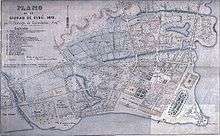
On April 7, 1521, Portuguese explorer Ferdinand Magellan landed in Cebu. He was welcomed by Rajah Humabon (also known as Sri Humabon or Rajah Humabara), the grandson of Sri Lumay, together with his wife and about 700 native islanders. Magellan, however, was killed in the Battle of Mactan, and the remaining members of his expedition left Cebu soon after several of them were poisoned by Humabon, who was fearful of foreign occupation. The last ruler of Sugbo, prior to Spanish colonization, was Rajah Humabon's nephew, Rajah Tupas (d. 1565).[11][12]
On February 13, 1565, Spanish conquistadors led by Miguel López de Legazpi together with Augustinian friars whose prior was Andrés de Urdaneta, arrived in Samar, taking possession of the island thereafter. They Christianized some natives and Spanish remnants in Cebu. Afterwards, the expedition visited Leyte, Cabalian, Mazaua, Camiguin and Bohol where the famous Sandugo or blood compact was performed between López de Legazpi and Datu Sikatuna, the chieftain of Bohol on March 16, 1565. The Spanish arrived in Cebu on April 15, 1565. They then attempted to parley with the local ruler, Rajah Tupas, but found that he and the local population had abandoned the town. Rajah Tupas presented himself at their camp on 8 May, feast of the Apparition of Saint Michael the Archangel, when the island was taken possession of on behalf of the Spanish King. The Treaty of Cebu was formalized on July 3, 1565. López de Legazpi's party named the new city "Villa de San Miguel de Cebú" (later renamed "Ciudad del Santísimo Nombre de Jesús)." In 1567 the Cebu garrison was reinforced with the arrival of 2,100 soldiers from New Spain (Mexico).[lower-alpha 1] The growing colony was then fortified by Fort San Pedro.
By 1569, the Spanish settlement in Cebu had become important as a safe port for ships from Mexico and as a jumping-off point for further exploration of the archipelago. Small expeditions led by Juan de Salcedo went to Mindoro and Luzon, where he and Martín de Goiti played a leading role in the subjugation of the Kingdoms of Tundun and Seludong in 1570. One year later, López de Legazpi departed Cebu to discuss a peace pact with the defeated Rajahs. An agreement between the conquistadors and the Rajahs to form a city council paved the way for the establishment of a new settlement and the construction of the Christian walled city of Intramuros on the razed remains of Islamic Manila, then a vassal-state of the Sultanate of Brunei.
In 1571, the Spanish carried over infantry from Mexico, to raise an army of Christian Visayan warriors from Cebu and Iloilo as well as mercenaries from the Tagalog region, and assaulted the Sultanate of Brunei in what is known as the Castilian War. The war also started the Spanish–Moro Wars waged between the Christian Visayans and Muslim Mindanao, wherein Moros burned towns and conducted slave raids in the Visayas islands and selling the slaves to the Sultanates of the Malay Archipelago and the Visayans fought back by establishing Christian fort-cities in Mindanao, cities such as Zamboanga City.
On August 14, 1595, Pope Clement VIII created the diocese of Cebu as a suffragan to the Archdiocese of Manila.
On April 3, 1898, local revolutionaries led by the Negrense Leon Kilat rose up against the Spanish colonial authorities and took control of the urban center after three days of fighting. The uprising was only ended by the treacherous murder of Leon Kilat and the arrival of soldiers from Iloilo.[14] On December 26, 1898, the Spanish Governor, General Montero, evacuated his troops to Zamboanga, turning over government property to Pablo Mejia.[15] The next day, a provincial government was formed under Luis Flores as president, General Juan Climaco as military chief of staff, and Julio Llorente as mayor.
American occupation and World War II
The signing of the Treaty of Paris at the end of the Spanish–American War provided for the cession of Cebu along with the rest of the Philippine islands to the United States until the formation of the Commonwealth Era (1935–46). On February 21, 1899, the USS Petrel (PG-2) deployed a landing party of 40 marines on the shores of Cebu.[16] Cebu's transfer to the American government was signed by Luis Flores although others, most notably General Arcadio Maxilom and Juan Climaco, offered resistance until 1901.[17] Governor W. H. Taft visited Cebu on April 17, 1901, and appointed Julio Llorento as the first provincial governor.[18] Juan Climaco was elected to that office in January 1904.[18]
After having remained a town since its original founding in 1565, Cebu became a chartered city on February 24, 1937. Many other Philippine cities such as Dansalan (now Marawi), Iloilo City, and Bacolod were also incorporated at that time (see Cities of the Philippines).
Along with the rest of the country, Cebu came under Japanese occupation during World War II. The Japanese encountered some opposition there from guerrillas and irregular forces led by Col. James Cushing and the Cebu Area Command. It was finally liberated with the Battle for Cebu City in March and April 1945. The military general headquarters of the Philippine Commonwealth Army and 8th Constabulary Regiment of the Philippine Constabulary, active from January 3, 1942 to June 30, 1946, was stationed in Cebu City during World War II.
Present day
Colon Street, the oldest national road in the Philippines, is the center of a dense and compact area in downtown Cebu City that was once the heart of Cebu City's shopping and business activity, with fashionable shops, restaurants and movie houses. In the early 1990s, much of this activity shifted to the more modern and more diverse business districts located in almost all of the urban areas of the city, including in what was considered residential and leisure neighborhoods. Colon also serves as a transit point for public utility jeepneys (PUJ) covering arterial routes within the city.
Geography
Cebu City has a land area of 315 square kilometres (122 sq mi). To the northeast of the city is Mandaue City and the town of Consolacion; to the west is Toledo City and the towns of Balamban and Asturias; to the south is Talisay City and the town of Minglanilla.
Across Mactan Strait to the east is Mactan island where Lapu-Lapu is located. Further east across the Cebu Strait is the island of Bohol.
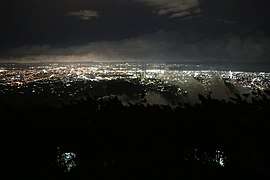 Skyline of central Cebu City at night
Skyline of central Cebu City at night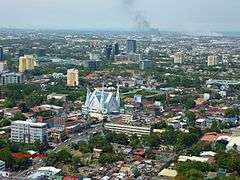 Aerial view of Cebu City North district
Aerial view of Cebu City North district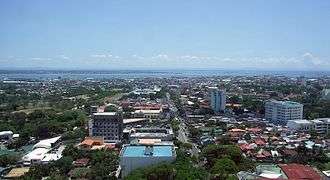 Panorama of Cebu City South district
Panorama of Cebu City South district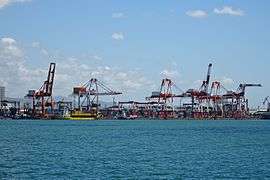 Harbor of Cebu City Pier 1
Harbor of Cebu City Pier 1
Barangays
The city comprises 80 barangays. These are grouped into two congressional districts, with 46 barangays in the northern district and 34 in the southern district.[19][20][21][22] The three most populous are Guadalupe (> 61,000), Lahug (> 38,000), and Tisa (> 37,000).

| North | South | ||||||||||||||||||||||||||||||||||||||||||||||||||||||||||||||||||||||||||||||||||||||||||||||||||||||||||||||||||||||||||||||||||||||||||||||||||||||||||||||||||||||||||||||||||||||||||||||||||||||||||||||||||||||||||||||||||||||||||||||||||||||||||||||||||||||||||||||||||||||||||||||||||||||||||||||||||||||||||||||||||||||||||||||||||||||||||||||||||||||||||||||||||||||||||||||||||||||||||||||||||||||||||||||||||||||||||||||||||||||||||||||||||||||||||||||||||||||||||||||||||||||||||||||||||||||||||||||||||||||||
|---|---|---|---|---|---|---|---|---|---|---|---|---|---|---|---|---|---|---|---|---|---|---|---|---|---|---|---|---|---|---|---|---|---|---|---|---|---|---|---|---|---|---|---|---|---|---|---|---|---|---|---|---|---|---|---|---|---|---|---|---|---|---|---|---|---|---|---|---|---|---|---|---|---|---|---|---|---|---|---|---|---|---|---|---|---|---|---|---|---|---|---|---|---|---|---|---|---|---|---|---|---|---|---|---|---|---|---|---|---|---|---|---|---|---|---|---|---|---|---|---|---|---|---|---|---|---|---|---|---|---|---|---|---|---|---|---|---|---|---|---|---|---|---|---|---|---|---|---|---|---|---|---|---|---|---|---|---|---|---|---|---|---|---|---|---|---|---|---|---|---|---|---|---|---|---|---|---|---|---|---|---|---|---|---|---|---|---|---|---|---|---|---|---|---|---|---|---|---|---|---|---|---|---|---|---|---|---|---|---|---|---|---|---|---|---|---|---|---|---|---|---|---|---|---|---|---|---|---|---|---|---|---|---|---|---|---|---|---|---|---|---|---|---|---|---|---|---|---|---|---|---|---|---|---|---|---|---|---|---|---|---|---|---|---|---|---|---|---|---|---|---|---|---|---|---|---|---|---|---|---|---|---|---|---|---|---|---|---|---|---|---|---|---|---|---|---|---|---|---|---|---|---|---|---|---|---|---|---|---|---|---|---|---|---|---|---|---|---|---|---|---|---|---|---|---|---|---|---|---|---|---|---|---|---|---|---|---|---|---|---|---|---|---|---|---|---|---|---|---|---|---|---|---|---|---|---|---|---|---|---|---|---|---|---|---|---|---|---|---|---|---|---|---|---|---|---|---|---|---|---|---|---|---|---|---|---|---|---|---|---|---|---|---|---|---|---|---|---|---|---|---|---|---|---|---|---|---|---|---|---|---|---|---|---|---|---|---|---|---|---|---|---|---|---|---|---|---|---|---|---|---|---|---|---|---|---|---|---|---|---|---|---|---|---|---|---|---|---|---|---|---|---|---|---|---|---|---|---|---|---|---|---|---|---|---|---|---|---|---|---|---|---|---|---|---|---|---|---|---|---|---|---|---|---|---|---|---|---|---|---|---|---|---|---|---|---|---|---|---|---|---|---|---|---|---|---|---|---|---|---|---|---|---|---|---|---|---|---|---|---|---|
|
| ||||||||||||||||||||||||||||||||||||||||||||||||||||||||||||||||||||||||||||||||||||||||||||||||||||||||||||||||||||||||||||||||||||||||||||||||||||||||||||||||||||||||||||||||||||||||||||||||||||||||||||||||||||||||||||||||||||||||||||||||||||||||||||||||||||||||||||||||||||||||||||||||||||||||||||||||||||||||||||||||||||||||||||||||||||||||||||||||||||||||||||||||||||||||||||||||||||||||||||||||||||||||||||||||||||||||||||||||||||||||||||||||||||||||||||||||||||||||||||||||||||||||||||||||||||||||||||||||||||||||
| NB As per REPUBLIC ACT NO. 9905, Banawa-Englis was supposed to be the 81st barangay in the city after being carved out from barangays Guadalupe and Labangon, however the law lapsed after the needed plebiscite didn't pass.[24][25][26][27] | |||||||||||||||||||||||||||||||||||||||||||||||||||||||||||||||||||||||||||||||||||||||||||||||||||||||||||||||||||||||||||||||||||||||||||||||||||||||||||||||||||||||||||||||||||||||||||||||||||||||||||||||||||||||||||||||||||||||||||||||||||||||||||||||||||||||||||||||||||||||||||||||||||||||||||||||||||||||||||||||||||||||||||||||||||||||||||||||||||||||||||||||||||||||||||||||||||||||||||||||||||||||||||||||||||||||||||||||||||||||||||||||||||||||||||||||||||||||||||||||||||||||||||||||||||||||||||||||||||||||||
Climate
Cebu City has a tropical monsoon climate under the Köppen climate classification. The city has a lengthy wet season and a short dry season, with only the months of March and April falling into the latter season. Average temperatures show little variance during the year with average daily temps ranging from 27 °C (81 °F) to 29 °C (84 °F). The city on averages experiences roughly 1,700 millimetres (67 in) of precipitation annually.
| Climate data for Cebu City (Mactan International Airport) 1981–2010, extremes 1972–2012 | |||||||||||||
|---|---|---|---|---|---|---|---|---|---|---|---|---|---|
| Month | Jan | Feb | Mar | Apr | May | Jun | Jul | Aug | Sep | Oct | Nov | Dec | Year |
| Record high °C (°F) | 33.5 (92.3) |
34.8 (94.6) |
33.9 (93.0) |
35.6 (96.1) |
37.0 (98.6) |
37.6 (99.7) |
35.3 (95.5) |
35.6 (96.1) |
35.2 (95.4) |
34.4 (93.9) |
33.8 (92.8) |
34.0 (93.2) |
37.6 (99.7) |
| Average high °C (°F) | 29.8 (85.6) |
30.2 (86.4) |
31.1 (88.0) |
32.3 (90.1) |
32.8 (91.0) |
32.1 (89.8) |
31.5 (88.7) |
31.7 (89.1) |
31.8 (89.2) |
31.4 (88.5) |
31.0 (87.8) |
30.2 (86.4) |
31.3 (88.3) |
| Daily mean °C (°F) | 26.8 (80.2) |
27.1 (80.8) |
27.8 (82.0) |
28.8 (83.8) |
29.3 (84.7) |
28.8 (83.8) |
28.2 (82.8) |
28.4 (83.1) |
28.3 (82.9) |
28.1 (82.6) |
27.8 (82.0) |
27.3 (81.1) |
28.1 (82.6) |
| Average low °C (°F) | 23.9 (75.0) |
24.0 (75.2) |
24.5 (76.1) |
25.4 (77.7) |
25.8 (78.4) |
25.4 (77.7) |
24.9 (76.8) |
25.0 (77.0) |
24.9 (76.8) |
24.8 (76.6) |
24.7 (76.5) |
24.3 (75.7) |
24.8 (76.6) |
| Record low °C (°F) | 19.8 (67.6) |
20.0 (68.0) |
19.4 (66.9) |
22.1 (71.8) |
22.0 (71.6) |
22.5 (72.5) |
20.8 (69.4) |
20.8 (69.4) |
21.5 (70.7) |
21.6 (70.9) |
20.4 (68.7) |
20.0 (68.0) |
19.4 (66.9) |
| Average rainfall mm (inches) | 105.2 (4.14) |
69.6 (2.74) |
58.6 (2.31) |
48.1 (1.89) |
95.0 (3.74) |
175.6 (6.91) |
192.9 (7.59) |
143.5 (5.65) |
179.6 (7.07) |
194.8 (7.67) |
161.9 (6.37) |
139.7 (5.50) |
1,564.5 (61.59) |
| Average rainy days (≥ 0.1 mm) | 12 | 9 | 8 | 6 | 8 | 14 | 16 | 14 | 15 | 16 | 14 | 14 | 146 |
| Average relative humidity (%) | 83 | 81 | 79 | 77 | 78 | 81 | 82 | 81 | 82 | 83 | 83 | 84 | 81 |
| Source: PAGASA[28][29] | |||||||||||||
Demographics
The population reached 799,762 people in 2007, and at the 2010 census, the city's population had grown to 866,171 in over 161,151 households.[3]
The most recent census data on ethnicity (based on the 2010 census) shows that the vast majority of the city's population speaks Cebuano.[32]
Religion
Christianity in the form of Roman Catholicism is the predominant religion in Cebu for about 80% of the population. The remainders are divided with various Protestant faiths (Baptist, Methodists and Presbyterian), Non-denominational, Iglesia Ni Cristo, The Church of Jesus Christ of Latter Day Saints (Mormon), Jehovah's Witnesses, Seventh-day Adventist and other Christian groups. Other religions include Islam, Hinduism and Buddhism.
Within the city is the Cebu Taoist Temple, a Taoist temple located in Beverly Hills.
Economy
Ceboom, a portmanteau of Cebu and Boom, has been used to refer to the rapid economic development of both Cebu City and Cebu Province in the early 1990s.[33]
With Cebu city's proximity to many islands, beaches, hotel and resorts, diving locations and heritage sites, high domestic and foreign tourist arrivals have fueled the city's tourism industry. Due to its geographic location, accessibility by air, land and sea transportation, Cebu City has become the tourist gateway to Central and Southern Philippines. Its port, Port of Cebu, is the country's second largest seaport.[34]
The city is a major hub for the business process outsourcing industry of the Philippines. In 2013, Cebu ranked 8th worldwide in the "Top 100 BPO Destinations Report" by global advisory firm, Tholons.[35][36] In 2012, the growth in IT-BPO revenues in Cebu grew 26.9 percent at $484 million, while nationally, the industry grew 18.2 percent at $13 billion.[37]
Aboitiz Equity Ventures, formerly known as Cebu Pan Asian Holdings, is the first holding company from Cebu City publicly listed in the Philippine Stock Exchange. Ayala Corporation, through its subsidiary Cebu Holdings, Inc. and Cebu Property, both publicly in the PSE Index, developed the Cebu Park District where the mixed-used development zones of the Cebu Business Park and Cebu IT Park are located. Both master planned areas are host to regional headquarters for various companies in the banking, finance, IT and tourism sectors among others.
Shipbuilding companies in Cebu have manufactured bulk carriers of up to 70,000 metric tons deadweight (DWT) and double-hulled fast craft as well. This industry made the Philippines the 4th largest shipbuilding country in the world.[38]
With a revenue growth rate of 18.8 percent in 2012, the real estate industry is the fastest growing sector in Cebu. With the strong economic indicators and high investors' confidence level, more condominium projects and hypermarkets are being developed in the locality.[39]
The South Road Properties (SRP) is a 300-hectare (740-acre) prime property development project on a reclaimed land located a few metres off the coast of Cebu's central business district. It is a mixed-use development that will feature entertainment, leisure, residential and business-processing industries.[40] It is registered with the Philippine Economic Zone Authority (PEZA) and is funded by the Japan Bank for International Cooperation(JBIC).[41] Traversing the property is a 12-kilometre (7.5 mi), four-lane highway known as the Cebu Coastal Road that provides the motorists with a good view of Cebu's south coast and the nearby island of Bohol.
Ayala Center Cebu is a shopping mall at the Cebu Business Park. More than 85,000 people visit this mall every day, with the figure increasing to 135,000 daily on weekends.[42] A second mall located in IT Park was opened last December 6, 2019, dubbed as Ayala Malls Central Bloc.
Local government
Being a highly urbanized city, Cebu City (along with neighboring Mandaue and Lapu-Lapu) is independent from Cebu province. Its electorate do not vote for provincial officials. There were proposals during the time of Governor Emilio Mario Osmeña to establish an "administrative district" that would be independent from Cebu City. This would mean carving out Cebu City's Capitol Site barangay, where the provincial capitol and other provincial offices are located. The plan, however, did not go through and was even followed by other proposals like the transfer of the capital to Balamban.
Cebu City is governed by a mayor, vice mayor and sixteen councilors (eight representing the north and eight representing the south districts). Each official is popularly elected to serve for a three-year term. The chief of the Association of Barangay Captains and the president of the Sangguniang Kabataan Federation also serve in the city council. The day-to-day administration of the city is handled by a city administrator.[43][44]
- Current city officials (2019-2022)
- Mayor: Edgardo C. Labella (PDP-Laban)[45]
- Vice Mayor: Michael L. Rama (UNA)[45]
- House of Representatives
- 1st District (North): Raul del Mar (LP)
- 2nd District (South): Rodrigo Abellanosa (LDP)
Culture

Cebu City is a significant cultural center in the Philippines. The imprint of Spanish and Roman Catholic culture is evident. The city's most famous landmark is Magellan's Cross. This cross, now housed in a chapel, is reputed to have been erected by Ferdinand Magellan (Fernão Magalhães) when he arrived in the Philippines in 1521.[46] It was encased in hollow tindalo wood in 1835 upon the order of the Augustinian Bishop Santos Gómez Marañon to prevent devotees from taking it home chip by chip. The same bishop restored the present template or kiosk, located at Magallanes Street between the City Hall and Colegio del Santo Niño. Revered by Filipinos, the Magellan's Cross is a symbol of Christianity in the Philippines.
A few steps away from Magellan's Cross is the Basilica Minore del Santo Niño (Church of the Holy Child). This is an Augustinian church elevated to the rank of basilica in 1965 during the 400th anniversary celebrations of Christianity in the Philippines, held in Cebu. The church, which was the first to be established in the islands, is built of hewn stone and features the country's oldest relic, the figure of the Santo Niño de Cebú (Holy Child of Cebu), who is Jesus Christ as a Child.
This religious and cultural event is celebrated during the island's cultural festivities known as the Sinulog festival. Held every third Sunday of January, it celebrates the festival of the Santo Niño, who was formerly considered to be the patron saint of Cebu. (This patronage was later changed to that of Our Lady of Guadalupe after it was realised that the Santo Niño could not be a patron saint because he was an image of Christ and not a saint.) The Sinulog is a dance prayer ritual of pre-Hispanic indigenous origin. The dancer moves two steps forward and one step backward to the rhythmic sound of drums. This movement resembles somewhat the current (sulog) of the river. Thus, the Cebuanos called it Sinulog.
When the Spaniards arrived in Cebu, the Italian chronicler Antonio Pigafetta, sailing under convoy with the Magellan expedition, offered a baptismal gift to Hara Amihan, wife of Rajah Humabon. She was later named Juana, the figure of the Santo Niño. The natives also honored the Santo Niño de Cebú in their indigenous sinulog ritual. This ritual was preserved but limited to honoring the Santo Niño. Once the Santo Niño church was built in the 16th century, the Christianized-Austronesian natives started performing the sinulog ritual in front of the church, the devotees offering candles and indigenous dancers shouting "Viva Pit Señor!"
In the 1980s and 2000s, the city authorities of Cebu added the religious feast of Santo Niño de Cebú during the Sinulog Festival to its cultural event.
The city joined UNESCO's Network of Creative Cities as a Design City on October 31, 2019 on the occasion of World Cities’ Day.[47]
Music
Cebu City is regarded as the birthplace of BisRock, a term coined by Cebuano writer Januar E. Yap in 2002.[48] Notable BisRock bands include Missing Filemon, Junior Kilat, Phylum, and Scrambled Eggs, among others. Filipino bands Urbandub and Cueshé also hail from Cebu, but mostly sing their songs in English, and in the latter's case, also in Tagalog.
The Cebu Reggae Festival is a popular Filipino Reggae and Roots music festival, it now has become one of the Philippines' largest annual Reggae Festivals.
Lifedance and Sinulog Invasion are rave music festivals held in the city in the days before the Sinulog Festival. These music festivals are regarded as among the biggest music festivals in the country.[49]
The Cebu Pop Music Festival is an annual music festival, founded in 1980,[50] showcasing Cebuano language pop songs. Like Lifedance and Sinulog Invasion, the music festival is also held in the days before the Sinulog Festival.
On Cebuano musical heritage, the Jose R. Gullas Halad Museum in V. Gullas St. (former Manalili) corner D. Jakosalem St. in Cebu City, holds musical memorabilia of Cebuano composers in the early 20th century, the likes of Ben Zubiri (composer of Matud Nila), Inting Rubi (Kasadya Ning Taknaa) and Minggoy Lopez (Rosas Pandan).
Since 2013, Cebu has hosted the Visayan Pop Songwriting Campaign, an annual songwriting competition that aimed to showcase songs written in the Cebuano language. Founded by multi-awarded artist Jude Gitamondoc, Ian Zafra, Cattski Espina, and Missing Filemon's front-man Lorenzo Niñal through the Artists and Musicians Marketing Cooperative (ArtistKo) with the support of the Filipino Society of Composers, Authors and Publishers. Vispop, or sometimes Visayan pop, later on evolved from being associated with the music festival to a genre of the new wave of Visayan pop songs that gained nationwide popularity, even those songs that were not exclusively produced for or presented in the contest.
Sports
The Cebu Schools Athletic Foundation, Inc. is based in the city. Its member schools are located within the Metro Cebu area. It is often considered as one of the Philippines' strongest college sports league.
The city has an active boxing scene. ALA Gym, one of the most famous boxing gyms in the Philippines, is based in the city, at the Banilad district. In addition, ALA Gym's promotion arm, the ALA Promotions, organizes the Pinoy Pride boxing series.
The Aboitiz Football Cup is the longest-running association football competition in Cebu. The cup has been considered to be one of the most prestigious association football tournaments in Cebu. The tournament is organized and supported by the Aboitiz family, one of the Philippines' richest families, and owners of one of the Philippines' largest conglomerates, the Aboitiz Equity Ventures.
The Cebu City Sharks is currently the only professional sports team that is playing in the city. The team plays in the South Division of the Maharlika Pilipinas Basketball League (MPBL). The team plays its home games at the Hoops Dome in nearby Lapu-Lapu City and at the USJ-R Coliseum, located in Barangay Basak Pardo.
Former professional sports teams include the following:
- Global Cebu F.C., which played in the now-defunct Philippines Football League (PFL). They played their home games at the Cebu City Sports Complex. They have since moved to Makati, changing their name correspondingly into Global Makati F.C..
- Cebu City Chiefs, a rugby league team that participated in the Philippines National Rugby League
- Cebu Dragons, a rugby union team in the Philippine Rugby Football Union
- Cebu Gems, a basketball team that played in the now-defunct Metropolitan Basketball Association (MBA). The Gems played their home games at the Cebu Coliseum.
Tourism
Tourism is a thriving industry in Cebu. It hosted the 1998 ASEAN Tourism Forum. The city also hosted the East Asian Tourism Forum on August 2002, in which the province of Cebu is a member and signatory.
Views of Cebu City and its skyline can be seen from villages and numerous gated communities located on its mountainsides.
There is a significant number of Filipino-Spanish heritage buildings in Cebu City such as Fort San Pedro, Basilica del Santo Niño, Magellan's Cross, and the Cebu Metropolitan Cathedral.[51] The city hosts the Museo Sugbo and Casa Gorordo Museum. The Cebu Taoist Temple is also situated within the city.
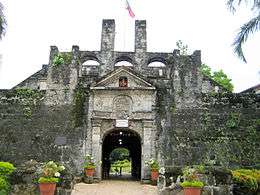
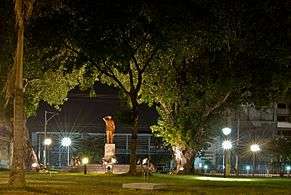 Plaza Independencia de Cebu
Plaza Independencia de Cebu.jpg)
- Waterfront Cebu City Hotel
Infrastructure
Transportation
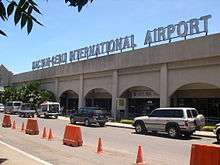
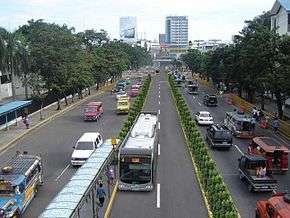
Mactan–Cebu International Airport, located in Lapu-Lapu City, is the country's second-busiest airport and serves direct international flights to Hong Kong, Malaysia, Singapore, Japan, China, Taiwan, Dubai and South Korea, with charter flights to Russia and domestic destinations.[52][53] Many international and cargo airlines fly to Cebu. There are also direct transfer flights via the capital's Ninoy Aquino International Airport that readily connect the city to other destinations in the world.
The city is served by a domestic and international port which are handled by the Cebu Port Authority. Much of the city's waterfront is actually occupied by the port with around 3.5 kilometres (2.2 mi) of berthing space. The city is home to more than 80% of the country's island vessels traveling on domestic routes mostly in the Visayas and Mindanao.[34]
Transportation throughout the city and the metropolitan itself is provided by jeepneys, buses and taxis. The Cebu City Government conducted a 2012 feasibility study on implementing bus rapid transit (BRT) system that will ease the transportation of the residents in the city and throughout the entire Metro Cebu area.[54][55] Aimed to serve an estimated 330,000 passengers per day, the project would have a capacity of 176 buses running through 33 stations along Bulacao until Talamban with a link to South Road Properties.[56][57] The project is currently branded as TransCebu and is expected to be fully operational by 2017.[58] As of March 2017 it is already two years late, and the price has rocketed to ₱9.04 billion (US$180 million).[59]
In March 2019, the Land Transportation Franchising and Regulatory Board announced the opening of a new Premium Point-to-Point Bus Service in Cebu City with three express bus routes to Lapu-Lapu, Danao and Sibonga.[60]
Utilities
The city mostly gets its power from an interconnection grid with the Leyte Geothermal Power Plant, which also powers the majority of the Visayas.[61][62] Cebu is also powered by a coal-fired thermal plant with two units each generating 52.5-MW and 56.8-MW,[63] a 43.8-MW diesel power plant and 55-MW land-based gas turbine plants located at the Naga power complex which is planned to be rehabilitated and replaced with 150-MW coal units by 2016 and to be completed by 2019.[64]
Telecommunication facilities, broadband and wireless internet connections are available and are provided by some of the country's largest telecommunication companies.
In 1998, the 15-hectare (37-acre) Inayawan Sanitary Landfill was constructed to ease garbage disposal within the city. After 15 years, the landfill reached its lifespan and the Talisay city government recently allowed Cebu to temporarily dump its garbage in its own 2-hectare (4.9-acre) landfill.[65][66] In 2015, Cebu appropriated a total of ₱2.5 million to close and rehabilitate the landfill at Inayawan.[67]
Education
Cebu City currently has ten large universities each with a number of college branches throughout the city and more than a dozen other schools specialising in various courses. Among these schools is the University of San Carlos. It has five campuses around the metropolitan area. It is currently headed by the Society of the Divine Word.
The University of the Philippines Cebu, located at Camputhaw in the district near Lahug currently has eight courses and has plans of expansion and development. The U.P. Board of Regents elevated the status of U.P. Cebu as a constituent university of the University of the Philippines System on October 27, 2016.[68]
Another Catholic university in Cebu City is the University of San Jose–Recoletos which was established in 1947.[69] It is currently headed by the Augustinian Recollects and has two different campuses within the city, excluding a new campus outside the city located in the municipality of Balamban.
Cebu Normal University (CNU) was established in 1902 as a provincial normal school, a branch of the Philippine Normal School. It became an independent institution in 1924, a chartered college in 1976, and a university in 1998. CNU offers academic programs at the nursery, kindergarten, elementary, junior high, undergraduate, and graduate levels. CNU is designated by the Commission on Higher Education (CHED) as Center of Excellence (COE) in both Nursing Education and Teacher Education.[70]
The Cebu Doctors' University (formerly Cebu Doctors' College) was granted university status on November 2004. It is the only private school in the Philippines designated a university without having a basic education (pre-school – high school) curriculum; it caters mainly to courses related to the health services field. It was relocated to a nine-story main building in 2007 at the Cebu Boardwalk (now Dr. P.V. Larrazabal Jr. Avenue) in neighboring city of Mandaue, thus closing its old campus near the then Cebu Doctors' Hospital (now Cebu Doctors' University Hospital). As of 2016, the university now offers senior high school (grades 11 and 12)
The University of Cebu has three campuses located within the city: Its main campus, located in Sanciangko Street, offers degree programs such as a Bachelor of Science in Information Technology (BSIT), HRM, Computer Engineering, BSED and others. The Maritime Education & Training Center (METC), located in Barangay Mambaling, which hosts the university's maritime programs, was opened in 1991. Its third campus, in Barangay Banilad, was opened in June 2002.
Also located within in the city is the University of the Visayas, established in 1919, and is considered to be the first educational institution in Cebu which was granted with a university status. It was granted an autonomous status by the Commission on Higher Education (CHED) in 2010 and currently offers basic education and a number of courses in the tertiary level including medical courses (Medicine, Nursing, Dentistry, Pharmacy, Midwifery, and Health Care Services) which are housed in its campus in Banilad area. Aside from its campuses within Cebu City, it also has numerous campuses located around the province of Cebu.
Other noteworthy institutions in the city include Cebu Institute of Technology – University (formerly Cebu Institute of Technology), the main campus of Cebu Technological University (formerly the Cebu State College of Science and Technology), Southwestern University, University of Southern Philippines Foundation in Lahug and Mabini, Asian College of Technology (formerly Asian Computer Institute), Asian Institute of Technology, Benedicto College, Cebu Eastern College, Cebu International School, Colegio de la Inmaculada Concepcion, College of Technological Sciences Don Bosco Technical College–Cebu (DBTC), Saint Theresa's College of Cebu, Sacred Heart School - Ateneo de Cebu, Salazar Colleges of Science and Institute of Technology, and Velez College (together with its independently-administered medical school arm Cebu Institute of Medicine), among others.
Cebu City has 68 public elementary schools, 23 national high schools and 28 night high schools. These night high schools are operated by the city government.
The Cebu City Public Library and Information Center is the only public library in Cebu.
Sister cities
- International (in alphabetical order of the names of the cities)






.svg.png)
.svg.png)








- National
- Butuan, Agusan del Norte
- Davao City, Davao del Sur
- General Santos, South Cotabato
- Manila, Metro Manila
- Ozamiz, Misamis Occidental
- Cabanatuan, Nueva Ecija
See also
- List of parishes in Cebu
- List of people from Cebu
- Roman Catholic Archdiocese of Cebu
- Metro Cebu
Notes
- On orders of the King Philip II, 2,100 men arrived from Mexico.[13]
References
- "Municipal: Cebu City". PSGC Interactive. Quezon City, Philippines: Philippine Statistics Authority. Retrieved January 8, 2016.
- Census of Population (2015). "Region VII (Central Visayas)". Total Population by Province, City, Municipality and Barangay. PSA. Retrieved June 20, 2016.
- "PSA releases the 2015 Municipal and City Level Poverty Estimates". Quezon City, Philippines. Retrieved October 12, 2019.
- "Highlights of the Philippine Population 2015 Census of Population". Philippine Statistics Authority. May 19, 2016. Retrieved October 31, 2016.
- "History of Cebu". Cebu City Tour. Retrieved February 22, 2013.
- "Cebu & Philippines". International Eucharistic Congress 2016. Retrieved June 24, 2016.
- Cebu—Cradle of the Philippine Church and Seat of Far-East Christianity (PDF), International Eucharistic Congress 2016, December 4, 2014, retrieved December 4, 2014
- "Cebu Archdiocese Philippines - Archdiocese of Cebu Philippines". Ucanews. Archived from the original on March 3, 2016. Retrieved June 24, 2016.
- Aeon (December 29, 2014). "'Cradle of Christianity' or 'Seat of Christianity' in the Far East?". Retrieved June 24, 2016.
- Macachor, Celestino C. (2011). "Searching for Kali in the Indigenous Chronicles of Jovito Abellana". Rapid Journal. 10 (2). Archived from the original on July 3, 2012.
- Montebon, Marivir. Retracing Our Roots – A Journey into Cebu's Pre-Colonial Past. p. 15.
- "Spanish Expeditions to the Philippines". philippine-history.org. 2005.
- "Cebu Provincial Government". The Official Portal of the Province of Cebu. Retrieved June 24, 2016.
- Foreman 1906, p. 522.
- Foreman 1906, p. 523.
- Foreman 1906, p. 524.
- Foreman 1906, p. 526.
- "CEBU CITY NORTH DISTRICT URBAN BARANGAYS". Cebu City Official Website. Archived from the original on 25 August 2016. Retrieved 21 August 2016.
- "CEBU CITY NORTH DISTRICT RURAL BARANGAYS". Cebu City Official Website. Archived from the original on 25 August 2016. Retrieved 21 August 2016.
- "CEBU CITY SOUTH DISTRICT URBAN BARANGAYS". Cebu City Official Website. Archived from the original on 25 August 2016. Retrieved 21 August 2016.
- "CEBU CITY SOUTH DISTRICT RURAL BARANGAYS". Cebu City Official Website. Archived from the original on 25 August 2016. Retrieved 21 August 2016.
- Census of Population and Housing (2010). "Region VII (Central Visayas)". Total Population by Province, City, Municipality and Barangay. NSO. Retrieved June 29, 2016.
- "Republic Act No. 9905". The LawPhil Project. Retrieved June 24, 2016.
- Cebu Daily News 2012.
- Malinao, Tweeny M. (July 29, 2012). "Guadalupe votes to keep barangay intact". Philippine Daily Inquirer.
- Sun Star 2012.
- "Mactan International Airport, Cebu City Climatological Normal Values". Philippine Atmospheric, Geophysical and Astronomical Services Administration. Archived from the original on September 19, 2018. Retrieved September 19, 2018.
- "Mactan International Airport, Cebu City Climatological Extremes". Philippine Atmospheric, Geophysical and Astronomical Services Administration. Archived from the original on September 19, 2018. Retrieved September 19, 2018.
- Censuses of Population (1903–2007). "Region VII (Central Visayas)". Table 1. Population Enumerated in Various Censuses by Province/Highly Urbanized City: 1903 to 2007. NSO.
- Gonzales 2004.
- "Statistical Tables on Sample Variables from the results of 2010 Census of Population and Housing - Cebu". Philippine Statistics Authority.
- Cebu Daily News, Fernando Fajardo (January 11, 2013). "Has 'Ceboom' returned?". Archived from the original on January 13, 2013.CS1 maint: ref=harv (link)
- Victorina Zosa (August 2004). "Philippine – Japan Economic Linkages: A Case Study of Cebu" (PDF). Discussion Paper Series No. 2004-33. Philippine Institute for Development Studies. Retrieved March 16, 2017.
- "Cebu rises to 8th best site for BPOs". Sun Star Cebu. Retrieved March 18, 2013.
- "Metro Manila, Cebu among top global BPO destinations". Yahoo! Philippines. Retrieved March 18, 2013.
- "Non-voice overtakes voice operation in Cebu". Sun Star Cebu. Retrieved June 25, 2013.
- "Philippines Now the Fourth Largest Shipbuilding Country in the World". Manila Bulletin. February 7, 2013. Archived from the original on April 28, 2013.CS1 maint: ref=harv (link)
- "Real estate sector fastest growing industry in Cebu". Philippine Daily Inquirer. Retrieved June 25, 2013.
- "About South Road Properties". City Government of Cebu. Archived from the original on March 1, 2013. Retrieved February 20, 2013.
- "The Official Cebu City Government Forum". Republic of the Philippines: Cebu City Government. Archived from the original on January 9, 2010. Retrieved January 12, 2010.
- "Philippine Daily Inquirer - Cebuanos develop shopping, leisure habits". Archived from the original on February 26, 2009.
- "Davide is acting Cebu City mayor Osmeña in US, Rama off to Korea". Cebu Daily News (Inquirer.net). October 10, 2008. Archived from the original on October 11, 2008. Retrieved October 10, 2008.
- "Osmeñas leave for US amid prayer". Philippine Daily Inquirer. Archived from the original on 11 October 2008. Retrieved 8 October 2008.
- "Labella, Rama take oath as Cebu City's new top execs". Philippine Daily Inquirer. Retrieved July 3, 2019.
- Chisholm, Hugh, ed. (1911). "Cebú". Encyclopædia Britannica. 5 (11th ed.). Cambridge University Press. pp. 592–593.
- "UNESCO celebrates World Cities Day designating 66 new Creative Cities". UNESCO. October 30, 2019. Retrieved November 5, 2019.
- "BISROCK: Where it all began". The Philippine Star. August 31, 2006. Retrieved August 1, 2017.
- Cabiluna, Pearl. "Top Sinulog Parties! – Everything Cebu". www.everythingcebu.com.
- Costanilla, Sam (September 11, 2016). "Costanilla: Cebu Pop Music Festival names top 12 songs". SunStar. Retrieved August 1, 2017.
- Department of Tourism Philippines official website page on Cebu. Accessed 28 September 2009.
- Cebu Pacific Air (July 18, 2006). "Cebu Pacific adds flights to Cagayan de Oro, Tacloban and Tagbilaran to meet demand".
- "Mactan Cebu airport to set aside P300M for expansion". Philippine Daily Inquirer. Archived from the original on September 16, 2008. Retrieved August 21, 2008.
- Mosqueda, M. W. (May 30, 2014). "NEDA okays bus rapid transit system for Cebu". Manila Bulletin. Retrieved September 23, 2015.
- "Funding for Cebu Bus Rapid Transit system approved". Rappler. August 27, 2014. Retrieved September 23, 2015.
- Agcaoili, L. (June 8, 2015). "DOTC eyes consultant for P10.6-B bus rapid transit system in Cebu". The Philippine Star. Retrieved September 23, 2015.
- "Gov't signs WB loan for Cebu bus rapid transit project". Rappler. October 31, 2014. Retrieved September 23, 2015.
- Montalbo, C. M. (April 10, 2015). "The dignity of travel: The Cebu BRT project". Archived from the original on April 24, 2015. Retrieved September 23, 2014.
- Cebu Daily News 2017.
- San Juan, Alexandria Dennise (March 19, 2019). "LTFRB opens 28 P2P routes for franchise". Manila Bulletin. Retrieved March 23, 2019.
- Rivera, D. O (November 18, 2013). "Yolanda-hit Leyte geothermal plant key to restoring power in Visayas". GMA News. Retrieved September 23, 2015.
- Felicitas, P. D. H. (February 6, 2014). "Cebu still has ample supply". Sun.Star. Archived from the original on November 17, 2015. Retrieved September 23, 2015.
- Lectura, L. (October 1, 2014). "SPC is new owner and operator of Naga power plant in Cebu". Business Mirror. Retrieved September 23, 2015.
- Garcia-Yap, A. (May 30, 2015). "New P25-B power plant to rise in Naga in 2019". Philippine Daily Inquirer. Retrieved September 23, 2015.
- Quintas, K. B. (January 23, 2015). "Talisay allows Cebu City to use its sanitary landfill". The Philippine Star. Retrieved September 23, 2015.
- "Talisay OKs Cebu City to Use Sanitary Landfill". MetroCebu News. January 23, 2015. Retrieved September 23, 2015.
- Quintas, K. M. (June 6, 2015). "City allocates P2.5M for landfill closure, rehab". The Philippine Star. Retrieved September 23, 2015.
- "UP Cebu is now UP's 8th Constituent University". Archived from the original on November 28, 2016. Retrieved March 19, 2017.
- "History". University of San Jose-Recoletos. Retrieved April 27, 2013.
- https://ched.gov.ph/wp-content/uploads/2017/09/List-of-COE-COD-as-of-May-2016.pdf
- "Cebu, Chengdu sign sister-city pact". SunStar. Retrieved July 29, 2019.
- "International Friendship Commission". City of Chula Vista. Retrieved July 29, 2019.
- "Sister Cities, Public Relations". Guadalajara municipal government. Archived from the original on March 2, 2012. Retrieved March 12, 2013.
- "International Relations and Sister-City Program: Cebu, Philippines". City of Honolulu. Retrieved July 29, 2019.
- "Haarlemmermeer Officials sojourn here". City of Cebu. Retrieved December 9, 2016.
- "Sister & Friendly Cities". Kaohsiung City Government. Archived from the original on July 6, 2018. Retrieved July 6, 2018.
- "Cebu City renews sister city ties with Belgium's Kortrijk". Cebu Daily News. Retrieved July 29, 2019.
- "Cebu City renews sister ties after 18 years". The Philippine Star. Archived from the original on November 22, 2015. Retrieved July 29, 2019.
- "Cebu City, Sabrosa formalizes sister-city agreement in Ferdinand Magellan's birthplace". Embassy of the Philippines in Portugal. October 2, 2014. Retrieved July 29, 2019.
- "Sister Cities". City of Salinas. Retrieved July 29, 2019.
- "Seattle International Sister City: Cebu, Philippines". City of Seattle. Archived from the original on March 22, 2014. Retrieved June 7, 2014.
- "Let's not reject old allies". SunStar Cebu. Retrieved December 10, 2016.
- "Russian-Philippines Relations". Embassy of the RUssian Federation in the Philippines. Archived from the original on September 15, 2013. Retrieved July 29, 2019.
- "Rama renews ties with Xiamen City". The Philippine Star. Retrieved July 12, 2014.
- "Cebu Yokohama Cities joint survey mission". City of Cebu. Retrieved December 9, 2016.
- "Sokor execs in Cebu City to strengthen partnership". The Philippine Star. Retrieved July 29, 2019.
Sources
- Cebu Daily News, Doris C. Bongcac & Tweeny M. Malinao (June 22, 2012). "Guadalupe plebiscite scheduled on July 28".CS1 maint: ref=harv (link)
- Philippine Daily Inquirer, Jose Santino S. Bunachita (January 3, 2017). "Road right-of-way costs up for BRT". Archived from the original on February 27, 2017.CS1 maint: ref=harv (link)
- Foreman, John (1906). The Philippine Islands. A political, geographical, ethnographical, social and commercial history of the Philippine Archipelago and its political dependencies, embracing the whole period of Spanish rule (3rd ed.). New York: Charles Scribner's Sons.CS1 maint: ref=harv (link)
- Gonzales, Glenda R. (December 2004). "Metro Cebu: A Metropolitan Area in Need of Coordinative Body" (PDF). Discussion Paper. 2004-49. PIDS. Archived (PDF) from the original on March 10, 2016. Retrieved February 16, 2016.CS1 maint: ref=harv (link)
- "A 'megadome' for Cebu City: Councilor Jack". SunStar. 16 May 2007. Archived from the original on 16 January 2010. Retrieved 11 June 2009.
- "Wenceslao: Banawa-Englis dream shot down". SunStar. August 1, 2012. Archived from the original on August 1, 2012.CS1 maint: ref=harv (link)
External links
| Wikimedia Commons has media related to Cebu City. |
| Wikivoyage has a travel guide for Cebu City. |

